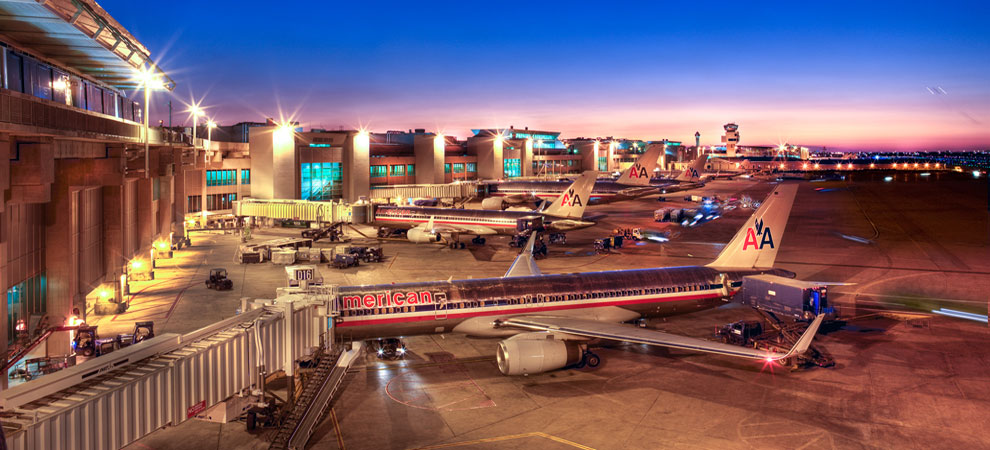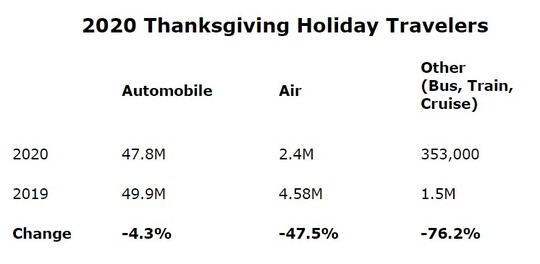The WPJ
THE WORLD PROPERTY JOURNALReal Estate Facts Not Fiction
Vacation Real Estate News

Thanksgiving Travel in U.S. to Dip 10 Percent, Largest Decrease Since 2008 Recession
Vacation News » Miami Edition | By Michael Gerrity | November 25, 2020 9:00 AM ET
Rising COVID cases and renewed quarantine restrictions dampen 2020 travel demand
According to AAA Travel, Thanksgiving will be on the lighter side when it comes to the typical number of travelers on U.S. roads and airports.
AAA reports the effects of the COVID-19 pandemic, including health concerns and high unemployment, are impacting Americans' decisions to travel for the 2020 Thanksgiving holiday. With health and government officials stressing that staying home is the best way to protect yourself and others from getting sick, AAA anticipates at least a 10% drop in travel - the largest one-year decrease since the Great Recession in 2008.
Based on mid-October forecast models, AAA would have expected up to 50 million Americans to travel for Thanksgiving - a drop from 55 million in 2019. However, as the holiday approaches and Americans monitor the public health landscape, including rising COVID-19 positive case numbers, renewed quarantine restrictions and the Centers for Disease Control and Prevention's (CDC) travel health notices, AAA expects the actual number of holiday travelers will be even lower.
"The wait-and-see travel trend continues to impact final travel decisions, especially for the Thanksgiving holiday," said Paula Twidale, senior vice president, AAA Travel. "The decision to travel is a personal one. For those who are considering making a trip, the majority will go by car, which provides the flexibility to modify holiday travel plans up until the day of departure."
Those who decide to travel by car are likely to drive shorter distances and reduce the number of days they are away, making road trips the dominant form of travel this Thanksgiving. Travel by automobile is projected to fall 4.3%, to 47.8 million travelers and account for 95% of all holiday travel.
AAA also anticipates Thanksgiving air travel volume will be down by nearly half of prior years - to 2.4 million travelers. This would be the largest one-year decrease on record. For these travelers, AAA notes holiday airfares are the lowest in three years. AAA further reports in-flight amenities, including food and beverage services, may not be available.
Travel by other modes, including buses, trains and cruises, is expected to decline 76%, to 353,000 travelers, as cruise ships remain docked and more travelers opt for car trips instead of taking buses or trains.
According to AAA Travel, Thanksgiving will be on the lighter side when it comes to the typical number of travelers on U.S. roads and airports.
AAA reports the effects of the COVID-19 pandemic, including health concerns and high unemployment, are impacting Americans' decisions to travel for the 2020 Thanksgiving holiday. With health and government officials stressing that staying home is the best way to protect yourself and others from getting sick, AAA anticipates at least a 10% drop in travel - the largest one-year decrease since the Great Recession in 2008.
Based on mid-October forecast models, AAA would have expected up to 50 million Americans to travel for Thanksgiving - a drop from 55 million in 2019. However, as the holiday approaches and Americans monitor the public health landscape, including rising COVID-19 positive case numbers, renewed quarantine restrictions and the Centers for Disease Control and Prevention's (CDC) travel health notices, AAA expects the actual number of holiday travelers will be even lower.
"The wait-and-see travel trend continues to impact final travel decisions, especially for the Thanksgiving holiday," said Paula Twidale, senior vice president, AAA Travel. "The decision to travel is a personal one. For those who are considering making a trip, the majority will go by car, which provides the flexibility to modify holiday travel plans up until the day of departure."
Those who decide to travel by car are likely to drive shorter distances and reduce the number of days they are away, making road trips the dominant form of travel this Thanksgiving. Travel by automobile is projected to fall 4.3%, to 47.8 million travelers and account for 95% of all holiday travel.
AAA also anticipates Thanksgiving air travel volume will be down by nearly half of prior years - to 2.4 million travelers. This would be the largest one-year decrease on record. For these travelers, AAA notes holiday airfares are the lowest in three years. AAA further reports in-flight amenities, including food and beverage services, may not be available.
Travel by other modes, including buses, trains and cruises, is expected to decline 76%, to 353,000 travelers, as cruise ships remain docked and more travelers opt for car trips instead of taking buses or trains.
Sign Up Free | The WPJ Weekly Newsletter
Relevant real estate news.
Actionable market intelligence.
Right to your inbox every week.
Real Estate Listings Showcase
Related News Stories
Vacation Real Estate Headlines
- Despite Geopolitical Uncertainty, European Hotel Values Rise
- Record 119 Million Americans Traveling Over the Christmas Holidays
- 80 Million Americans to Hit the Road, Skies and Seas for 2024 Thanksgiving Holiday
- Asia Pacific Hotel Investment to Exceed $12 Billion in 2024
- Asia Pacific Hotel Investment Tops $12 Billion in 2024
- Seattle, Orlando and New York Top Labor Day Destinations in 2024
- Record 71 Million Americans Traveling Over July Fourth Week
- Major Hotel Operators Expanding Rapidly Across Asia Pacific in 2024
- 44 Million Traveling Memorial Day Weekend, Second Most in History
- South Korea is Asia Pacific's Top Performing Hotel Market
- Florida Dominates Top 10 U.S. Cities List to Invest in Short Term Rentals
- Investment in South Korea Hotels Dipped in 2023
- European Hotel Values Still Below Pre-Covid Prices
- Over 115 Million Americans Traveling Over Christmas Holidays
- 55.4 Million Americans on the Move Thanksgiving Holiday
- Asia Pacific Tourism to Approach Full Recovery in 2024, Driving Hotel Sector Growth
- Asia Pacific Hotel Revenues to Rise in 2024 Despite Economic Volatility
- Tourist Bookings to Hawaii Down 50 Percent Since Maui Wildfires
- Demand for Vacation Homes in U.S. Hit 7-Year Low in August
- International Travel for Americans Jumps Over 200 Percent in 2023
- U.S. Labor Day Weekend Travel To Uptick in 2023
- Asia Pacific Hotel Investment Collapses 51 Percent in 2023
- As Summer Travel Season Winds Down, U.S. Gas Prices Rise Again
- Record Setting 50.7 Million Americans to Travel This July Fourth Holiday
- Israel Hotels Poised for Growth as International Visitors Set to Return
- Over 42 Million Americans to Travel This Memorial Holiday Weekend
- European Hotel Transactions Decline 18 Percent in 2022 as Interest Rates Surge
- U.S. Vacation Home Demand Dives 50 Percent from Pre-Pandemic Levels
- European Hotel Values Upticked 3 Percent in 2022
- U.S. Vacation Rental Bookings Rise 27 Percent Annually in January
- Third-Party Hotel Operators Set to Increase Across Europe in 2023
- 113 Million People Traveling in the U.S. During the 2022 Holiday Season
- London Hotels Set to Weather High Inflation in 2022
- Almost 55 Million People to Travel This Thanksgiving Holiday in America
- Düsseldorf Hotels Enjoy Growing Corporate Demand in 2022
- Global Hotel Investment Activity in Asia Pacific to Rise 80 Percent in 2022
- Japan Lifts Foreign Inbound Covid Travel Restrictions in October
- Demand for Second Vacation Homes in the U.S. Decline
- Amsterdam Hotels Enjoy Comeback Post Covid Travel Restrictions
- 47.9 Million Americans Will Travel This July 4th Weekend
Reader Poll
Marketplace Links
This website uses cookies to improve user experience. By using our website you consent in accordance with our Cookie Policy. Read More






